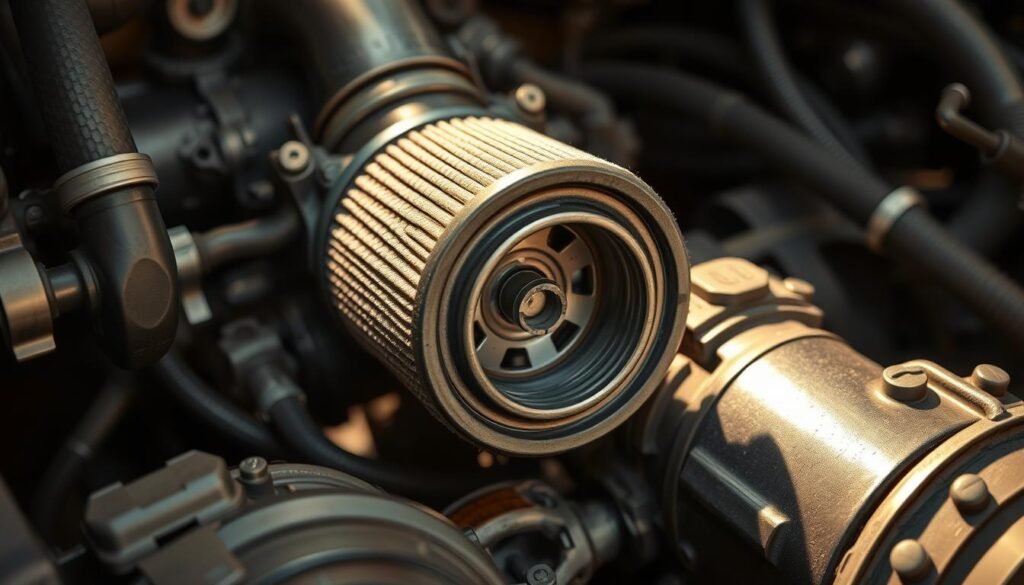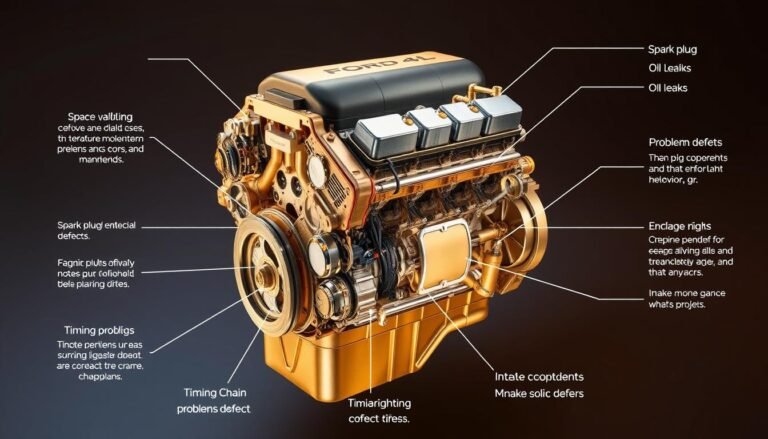Ford 6.7 Crankcase Filter Replacement Guide
Want to know how to replace the Ford 6.7 crankcase filter? This is key for your engine’s best performance. In this guide, you’ll learn all about replacing the crankcase filter.
You’ll see why regular maintenance is important. This guide will help you replace the filter confidently.
It will also help your engine last longer and meet environmental standards. The first thing to know is why the crankcase filter is so important.
It keeps your engine running well. You’ll learn about the tools and materials you need for the job.
Then, we’ll walk you through how to remove the old filter and put in a new one. We’ll also share common mistakes to avoid.
This way, you’ll have a smooth and effective replacement. After you replace the filter, we’ll give you tips to keep it working well for a long time.
You’ll also learn about choosing between OEM and aftermarket filters. By following this guide, your Ford 6.7 will stay in great shape. You’ll enjoy a reliable drive for years.
Introduction: Importance of Ford 6.7 Crankcase Filter Replacement
Replacing the Ford 6.7 crankcase filter is key to keeping your vehicle running well. This filter helps with airflow and stops sludge from building up in the engine.
It also keeps emissions in check, which is good for the environment. Not replacing the crankcase filter can cause big problems.
It can lead to engine wear, less power, and costly repairs. So, it’s important to keep your engine in top shape.
Regularly replacing the crankcase filter helps your engine last longer and run better. By following good maintenance tips, you can make your engine more efficient.
A clean crankcase filter means a smoother ride and fewer breakdowns.
What Is The CCV System?
The Ford 6.7 CCV system, or crankcase ventilation system, is key for engine performance and meeting environmental standards.
It moves gases from the crankcase back to the intake manifold for burning. This action cuts down on harmful emissions and stops sludge from building up in the engine.
An effective Ford 6.7 CCV system lowers internal pressure. This reduces the chance of oil leaks or engine damage.
It’s important to check this system often to make sure it’s working right. If the filter gets clogged, the whole engine’s performance can drop.
Keeping the crankcase ventilation system in good shape is vital. Regular maintenance and replacing filters on time are musts.
This helps your engine run well and meets environmental rules. Knowing how the Ford 6.7 CCV system works helps you keep your vehicle in top shape.
What Is The Ford 6.7 Crankcase Filter?
The Ford 6.7 crankcase filter is key to keeping your engine in top shape. It’s a vital part of the engine’s CCV system. This system manages gases in the crankcase and cuts down on emissions.
Definition and Functionality
The ford 6.7 crankcase filter catches bad stuff like oil vapors and particles. This helps keep the air in your engine clean. It makes sure the engine runs well and doesn’t pollute as much.
How It Affects Engine Performance?
How well your crankcase filter works affects your car’s performance a lot. A dirty filter can block airflow, hurting power and using more oil.
It can also cause unexpected emissions. Replacing it often keeps your engine running strong, boosting power and saving fuel.
| Factor | Effect of Clogged Filter | Recommended Action |
|---|---|---|
| Airflow | Restricted | Regular Replacement |
| Power Output | Decreased | Monitor Performance |
| Oil Consumption | Increased | Replace Filter |
| Emissions | Unusual Smoke | Inspect Filter Condition |
Significance of Regular Crankcase Filter Maintenance
Keeping your Ford 6.7 diesel engine’s crankcase filter in top shape is key for its best performance and life span.
Knowing the benefits of replacing the crankcase filter can make your engine run better and last longer.
A well-kept system helps save fuel, cuts down oil use, and keeps emissions cleaner.
Benefits of a New Filter
Regular filter care offers many perks. A fresh filter stops harmful sludge from building up, keeping your engine clean.
This means your engine works better, using less oil and fuel, and lasts longer.
- Enhanced engine performance
- Lower oil consumption
- Increased fuel efficiency
- Extended lifespan of engine components
Consequences of Neglect
Ignoring the filter can lead to big problems. Not replacing it can cause your engine to wear out faster and lose power.
Clogged filters can also lead to oil leaks and engine damage. Here are some serious risks of not replacing the Ford 6.7 crankcase filter:
- Increased risk of engine failure
- Higher oil consumption
- Potential compliance issues with environmental regulations
- Costly repairs due to neglected maintenance

Compromise these points shows how important crankcase filter maintenance is. Making it a priority keeps your engine running smoothly and efficiently.
This protects your investment for many years.
| Maintenance Aspect | Benefits | Risks of Neglect |
|---|---|---|
| Crankcase Filter Replacement | Improved engine performance, lower emissions | Increased engine wear, oil leaks |
| Regular Maintenance | Extended engine lifespan, better fuel efficiency | Decreased power, costly repairs |
| Sludge Prevention | Cleaner engine, reduced emissions | Compliance issues with regulations |
Signs Your Ford 6.7 Crankcase Filter Needs Replacement
Knowing when your crankcase filter is failing can stop bigger engine problems. Look out for signs like less power, more oil use, and odd exhaust smoke.
These are clear warnings that your Ford 6.7 crankcase filter needs a check-up.
Decreased Power and Performance
A big sign of a failing crankcase filter is when your engine’s power drops. If your car feels slow to start or lacks power, it might be the filter.
A clogged filter limits airflow, making your engine work harder. Keep an eye on how your car performs to see if it’s time for a filter check.
Increased Oil Consumption
Draining more oil than usual is a key sign of a bad crankcase filter. If you’re adding oil often and there are no leaks, your filter might be letting too much oil vapor in.
This means it’s not working right and needs to be replaced.
Unusual Exhaust Smoke
Seeing too much exhaust smoke, like blue or black, can mean your crankcase filter is not working. This smoke is oil vapor getting into the exhaust.
It hurts your engine’s performance and can make emissions worse. Spotting this smoke early can help fix problems before they get worse.
Preparing For The Ford 6.7 Crankcase Filter Replacement
Before starting the Ford 6.7 crankcase filter replacement, preparation is key. First, collect all the tools and materials you’ll need.
Make sure you have a new filter, an oil catch pan, wrenches, and a torque wrench. Then, check your vehicle’s service manual for specific instructions.
Each model has its own needs for this job. Also, remember to wear gloves and safety goggles for your safety. Having a clean workspace helps a lot.
Organize your tools so you can find them easily. Use a checklist for filter change to make sure you don’t miss any steps.
| Preparation Step | Description |
|---|---|
| Gather Tools | Collect all necessary tools and materials. |
| Consult Manual | Review the service manual for specific instructions. |
| Safety Gear | Wear gloves and goggles for protection. |
| Clean Workspace | Ensure your workspace is tidy and organized. |
| Checklist for Filter Change | Follow an organized checklist to ensure no steps are missed. |

Tools and Materials Needed For Replacement
Replacing the Ford 6.7 crankcase filter is easy with the right tools and materials. Using the correct tools for ford 6.7 crankcase filter replacement makes the job simpler.
It also ensures the process goes smoothly without any issues. Here are the essential tools and filter choices that will make your maintenance easier.
Essential Tools
Before starting, make sure you have these essential maintenance tools:
- Socket wrench set
- Torque wrench
- Oil catch pan to manage spills
- Gloves and goggles for safety
Recommended Filter Choices
Choosing a high-quality filter is key. The best ford 6.7 crankcase filter options ensure top performance.
OEM filters fit perfectly, but aftermarket filters can be a good value if they’re high-quality. Here are some top picks:
| Filter Type | Brand | Features |
|---|---|---|
| OEM | Ford Motor Company | Guaranteed compatibility, high-quality fit |
| Aftermarket | SPETUNER | Prevents sludge buildup, enhances engine efficiency |
Step-by-Step Guide To Replacing The Ford 6.7 Crankcase Filter
Replacing the Ford 6.7 crankcase filter is a detailed process. It ensures your engine runs smoothly. Follow these steps for a successful replacement.
Removing The Old Filter
First, find the crankcase filter on the engine, usually on the driver’s side. Remove any hoses or parts blocking your way. This step helps avoid damage.
After clearing the area, remove the old filter carefully. Watch out for debris or sludge. This is key in learning how to remove the ford 6.7 crankcase filter.
Installing The New Filter
Now, clean the area where you’ll install the new filter. Place the new filter in the correct spot, making sure it fits well. Then, reconnect all hoses and parts you removed.
Use a torque wrench to tighten everything right. This ensures no leaks. Following these steps makes the replacement smooth.
Final Checks Post-Replacement
After installing the new filter, do some final checks. Start the engine and listen for any odd sounds. Also, check for smoke.
Inspect all connections and hoses to make sure they’re tight. This step confirms everything is working right. It also boosts your confidence in the maintenance work.

Common Mistakes To Avoid During Replacement
Replacing the crankcase filter in your Ford 6.7 engine needs careful attention. Many people make mistakes, leading to problems later.
To replace it successfully, avoid these common pitfalls:
- Using non-OEM filters can compromise performance. Stick to genuine Ford parts to ensure proper function.
- Overlooking essential cleaning steps. Always clean the filter housing to remove debris and contaminants that could affect performance.
- Failing to secure components properly. Ensure all parts are tightened correctly to prevent leaks and airflow restrictions.
- Neglecting to check local regulations. Modifications might require compliance with certain standards, so familiarize yourself with any local guidelines.
To avoid errors while changing filter, follow a step-by-step approach. Being meticulous in your process significantly reduces the risk of problems.
When you focus on these aspects during the replacement, you improve your vehicle’s longevity and efficiency.
After Replacement: Maintenance Tips For Long-lasting Performance
After replacing the crankcase filter, keeping it in good shape is key. Regular checks for wear or sludge are important. This helps keep your engine running smoothly.
Make sure to follow the manufacturer’s schedule for replacements. By doing this, you can spot clogs early and keep your engine in great shape.
Here are some tips to help your engine last longer:
- Check the crankcase area often.
- Replace the filter as scheduled.
- Change the oil when needed.
- Keep the engine clean from dirt.
- Fix any problems right away to avoid bigger issues.

Regulatory Considerations For Modifications
When you modify your Ford 6.7 crankcase filter system, knowing the local laws is key. Each state has its own rules about emissions and the environment.
Ignoring these can lead to fines or failing inspections. Before you start, check if your changes follow emissions standards.
Inspectors look for compliance with environmental rules. Using parts that don’t meet local laws can cause legal and financial trouble.
To avoid problems, talk to a professional or do your homework on local laws. This way, you can make the most of your modifications and stay legal.
Benefits of Using OEM vs Aftermarket Filters
Choosing between OEM and aftermarket ford 6.7 crankcase filters is key. OEM filters fit perfectly and work best, improving your engine’s performance.
They also reduce the chance of leaks or engine failures. Aftermarket filters might be cheaper, but they can be less reliable.
A comparison shows that some aftermarket filters don’t filter as well. This can cause your engine to work harder and might damage it over time.
Going for OEM filters means better engine performance and health. It’s important to weigh the long-term benefits against the initial cost savings of aftermarket filters.
Conclusion
This guide is a detailed look at replacing the Ford 6.7 crankcase filter. It shows why regular maintenance is key for your vehicle.
A well-maintained crankcase filter boosts engine performance and meets emission standards.
Ignoring this part can make your engine less efficient and cost a lot to fix. Following the steps in this guide makes replacing the filter easy.
It keeps your Ford 6.7 running smoothly, saving you time and money. As a car owner, regular maintenance is essential.
It keeps your engine running well for a long time. This peace of mind is worth the effort.
FAQs
Q: How often should I replace the Ford 6.7 crankcase filter?
A: You should replace the Ford 6.7 crankcase filter every 10,000 to 15,000 miles. Or, when you see your engine’s performance drop or oil use go up.
Q: What are the benefits of using an OEM Ford 6.7 crankcase filter?
A: An OEM Ford 6.7 crankcase filter fits perfectly and works best. It keeps your engine running smoothly, cuts down on sludge, and reduces harmful emissions.
Q: Can I install the Ford 6.7 crankcase filter myself?
A: Yes, you can replace the Ford 6.7 crankcase filter yourself. Just make sure you’re ready with the right tools and follow the guide carefully.
Q: What tools do I need to replace the Ford 6.7 crankcase filter?
A: You’ll need a socket wrench set, a torque wrench, and an oil catch pan. Don’t forget gloves and goggles for safety.
Q: What signs indicate that my Ford 6.7 crankcase filter needs replacement?
A: Look out for signs like less engine power, more oil use, lots of exhaust smoke, and slow acceleration. These mean it’s time to check and possibly replace the filter.
Q: What happens if I neglect to replace the crankcase filter?
A: Not replacing the filter can cause serious engine damage. It can lead to less power, more oil leaks, and higher emissions. This might cost you a lot and could even get you in trouble with the law.
Q: How can I ensure proper maintenance of the crankcase filter?
A: Keep your crankcase filter in good shape by checking it regularly. Replace it as needed and watch for any signs of clogging or sludge.







